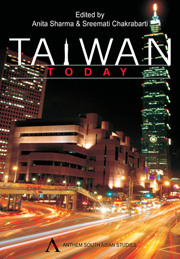Book contents
- Frontmatter
- Contents
- Acknowledgements
- Contributors to this Volume
- Acronyms and Abbreviations
- Foreword
- Introduction
- 1 Who are We? Identity in Transition
- 2 Taiwan: Yearning for an Identity
- 3 The Implications of Direct Flights: Beijing in Taiwanese Politics
- 4 Kuomintang, Democratization and the One-China Principle
- 5 The Deepening and Consolidation of Democracy in Taiwan
- 6 India and Taiwan: Bolstering Complementarity in Information Technology
- 7 Asian Regional Economic Integration and Taiwan–India Economic Relations
- 8 The Taiwan Factor in Sino–Indian Relations
- 9 Japan's Triumphant Diplomacy in Taiwan in 1874
- 10 A Study of the Cultural and Educational Exchanges between Taiwan and India, 1995–2006
- 11 Between Two Worlds: A Survey of Education in Taiwan
- 12 Female Immigrants, Social Capital and Public Sphere in Taiwan
- 13 Information Technology and Gender: Taiwan and India
- 14 Tzu Chi: A Case Study of Engaged Buddhism in Taiwan
- 15 Master Hsing Yun of Fo Guang Shan and the Development of Humanistic Buddhism
- 16 The Heritage and Innovation of Chan Paintings in Taiwan
- 17 Taiwan in World Architecture: A Historical Perspective
- Afterword
6 - India and Taiwan: Bolstering Complementarity in Information Technology
Published online by Cambridge University Press: 05 March 2012
- Frontmatter
- Contents
- Acknowledgements
- Contributors to this Volume
- Acronyms and Abbreviations
- Foreword
- Introduction
- 1 Who are We? Identity in Transition
- 2 Taiwan: Yearning for an Identity
- 3 The Implications of Direct Flights: Beijing in Taiwanese Politics
- 4 Kuomintang, Democratization and the One-China Principle
- 5 The Deepening and Consolidation of Democracy in Taiwan
- 6 India and Taiwan: Bolstering Complementarity in Information Technology
- 7 Asian Regional Economic Integration and Taiwan–India Economic Relations
- 8 The Taiwan Factor in Sino–Indian Relations
- 9 Japan's Triumphant Diplomacy in Taiwan in 1874
- 10 A Study of the Cultural and Educational Exchanges between Taiwan and India, 1995–2006
- 11 Between Two Worlds: A Survey of Education in Taiwan
- 12 Female Immigrants, Social Capital and Public Sphere in Taiwan
- 13 Information Technology and Gender: Taiwan and India
- 14 Tzu Chi: A Case Study of Engaged Buddhism in Taiwan
- 15 Master Hsing Yun of Fo Guang Shan and the Development of Humanistic Buddhism
- 16 The Heritage and Innovation of Chan Paintings in Taiwan
- 17 Taiwan in World Architecture: A Historical Perspective
- Afterword
Summary
INTRODUCTION
Taipei, the capital city of Taiwan, is a towering example of national pride and an impressive example of Information Technology (IT). Built in an earthquake prone region, the world's tallest building, Taipei 101 is a remarkable proof of architectural brilliance and resilience. Home to some of the finest universities, world-class research centres, sciences parks and computer-related products, India, which is 92 times bigger than Taiwan, can forge strong links and partnerships particularly in the field of IT.
The statistics are impressive and speak for themselves. Taiwan is ranked first in Asia and fourth in the world in growth competitiveness. It will be only appropriate to describe Taiwan's current economic situation and outlook for 2007. Economic growth, foreign trade, domestic investment, industrial production and employment are some of the key parameters that have been taken into account to do the forecasting.
TAIWAN'S FORECAST
Like weather, country forecasts could most of the times go wrong. The Economist says the political scene will remain unstable during 2007–08 in Taiwan quoting internecine squabbles between the ruling Democratic Progressive party (DPP) and the opposition, Kuomintang (KMT). But the economic development this year will be one of ‘stable adjustment’, says Academia Sinica, Taiwan's leading research institute. According to their report, ‘Overall Outlook for Taiwan's Economy 2007’, revived domestic demand will help Taiwan's real Gross Domestic Product (GDP) grow by 4.21 per cent this year.
- Type
- Chapter
- Information
- Taiwan Today , pp. 71 - 93Publisher: Anthem PressPrint publication year: 2010
- 1
- Cited by



